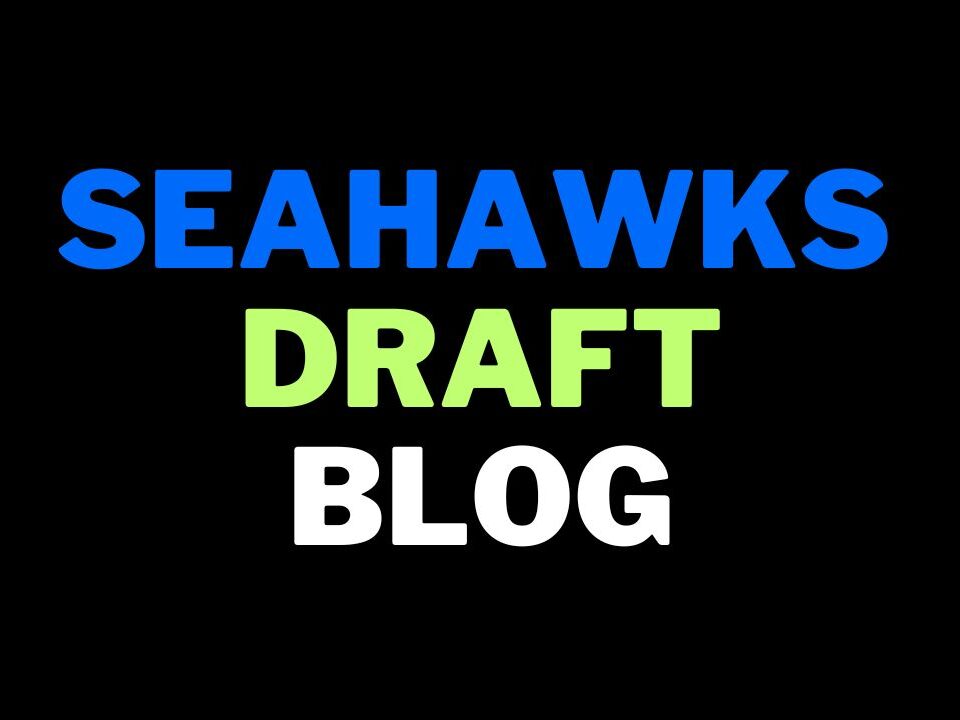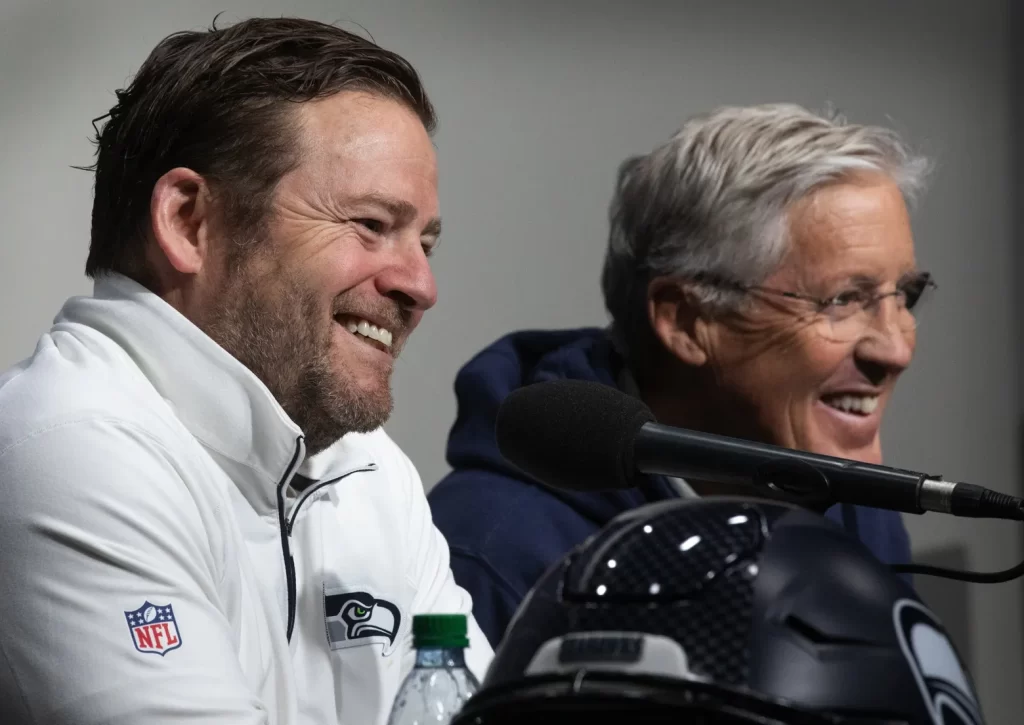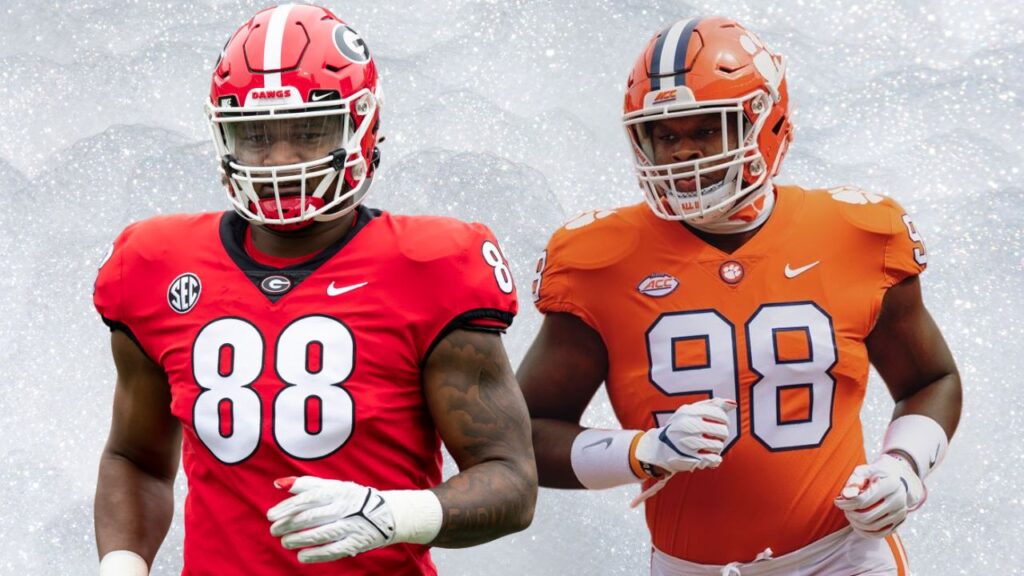Yesterday I wrote a two-round mock draft. Today, I’ve decided not to publish it.
I think there’s a bigger question that needs to be asked and it makes writing a mock draft at the moment totally pointless.
Who calls the shots?
Is it Pete Carroll or is it John Schneider?
Because who the key decision maker is will dictate and shape one of the most important off-seasons in Seahawks history.
Be warned, speculative thinking out loud is forthcoming.
It’s about a year since Jody Allen met with Carroll and Schneider and had an end of season meeting that was described as ‘routine’ by some in the media, yet turned out to be the precursor to significant coaching changes, schematic adjustments and the Russell Wilson trade.
It was also speculated at the time that Schneider might gain greater personnel control as a consequence of that meeting. That has never been confirmed and we’ll never know for sure but it was suggested as a possibility.
I suspect Schneider’s vision for the 2023 off-season will differ to Carroll’s and that makes this an important topic.
I think it’s why chatter like this exists:
I think the GM there has wanted someone else at head coach for some time now even if they won’t publicly acknowledge that… https://t.co/2hYSdCnUd7
— Benjamin Allbright (@AllbrightNFL) December 19, 2022
I think Schneider was always planning to draft a quarterback this off-season. It’s easy to forget but cast your mind back to last summer. Expectations were low. Most people assumed the Seahawks were starting Geno Smith in an attempt to just ‘see out the season’ before launching phase two of a major rebuild.
The 2023 quarterback class was being heavily talked up in the media — in my opinion, justifiably so. The Seahawks didn’t address the position at all last year apart from acquiring Drew Lock — who is out of contract as soon as the current season ends. It’s possible Schneider, as with other GM’s, was focused on the 2023 class.
Foundations were laid last off-season with the addition of book-end tackles. They also kept the players they felt provided a veteran presence (at great cost) such as Will Dissly and Quandre Diggs. Were they setting the stage to draft a QB?
The way they spent their money was also interesting. A lot of their 2023 cap space is gone already. The Seahawks have $28.5m in effective cap space to spend according to Over The Cap. In comparison, the Bears have $98m, the Falcons have $57m and the Giants have $44m. Even the Bengals have $10m more available at $38m.
The Seahawks only have the seventh most available spending money — and that’s with only 36 players signed for next season. Only the Chiefs and 49ers have fewer contracted players currently.
It’s easy to imagine everything was being geared towards having a cheap rookie quarterback in 2023. Or at least a rookie paired with a veteran bridge. If nothing else, you then have the money to fill out your roster — something that would be otherwise challenging with 36 players signed and only $28.5m to play with.
Travon Walker, the #1 overall pick a year ago, had a $6.7m cap hit as a rookie. His cap hit next season is only $8.5m. That would be the absolute maximum a young quarterback would cost Seattle, if they ended up with the top pick.
Instead they’ve gained the fifth pick, courtesy of the Broncos. Kayvon Thibodeax was the #5 selection a year ago. His rookie cap hit was only $5.7m.
This to me always felt like the plan. Draft a cost-effective quarterback early in 2023.
Then the season started and Geno Smith performed as he did.
I don’t think members of the front office ever anticipated a situation where fans would be calling for Smith to have his contract extended at $30m a year.
If they were anticipating Smith being a starter for the longer term, they likely wouldn’t have signed him to a mere $3.5m one-year deal with $3.5m in incentives. They would’ve paid more to get an extra year or two.
Smith’s performances in the first half of the season were unexpected and brilliant and have changed the discussion with many believing Seattle almost has to pay to keep him. I think a majority of fans want to ‘build around Geno’ rather than stick to what might’ve been the original plan of going younger and cheaper.
This is why I think whoever is calling the shots in the off-season really matters.
If John Schneider has final say
He may want to draft the younger quarterback still and plan for the future. They might be able to keep Geno Smith as a bridge — but that might be a bonus. They’re in position to select one of the top four quarterbacks in the draft — a rare opportunity for this franchise and GM.
I’ve watched all of their college games and I think all four QB’s warrant the pick. I also think players like Will Levis and Anthony Richardson absolutely fit what Schneider seems to value at the position. While people will dismiss the pair as not good enough (based mostly on what they read and hear from other people, it has to be said) — the reality is fans would’ve said the same things about Patrick Mahomes and Josh Allen. They had plenty of flaws, plenty of errors on tape and were seen as more potential over polish. They are also two players Schneider reportedly was very keen on.
This quote from Mike Tomlin was highlighted to me today and it rings so true:
“I love to hear coaches resist the responsibility of coaching… They’ll talk negatively about a dude that can’t learn and blah, blah. Man, if everybody could learn, we’d need less coaches. Right? If the group didn’t need management, then we wouldn’t make as much.
“I love reading draft evals and somebody’s talking about anything other than pedigree, talking about how poor somebody’s hand usage is. Well, that’s coaching. I don’t run away from coaching. I run to coaching. It all is in line with not seeking comfort, because when you’re a coach that’s talking about, ‘Somebody can’t learn,’ you’re seeking comfort because your teaching is struggling.”
The likes of Levis and Richardson have extreme physical qualities, pro-style experience and excellent character. These are qualities that will appeal greatly to Schneider (and other GM’s).
Let me go a step further. I think there’s every chance Schneider is determined to draft a quarterback. He comes from the Green Bay system — which has always valued the position. They drafted Aaron Rodgers in 2005 in order to be well prepared for Brett Favre’s retirement. They then spent a subsequent second round pick on Brian Brohm — despite the investment in Rodgers and the fact Favre was still playing.
Think about that for a second. At one point in 2008 Green Bay’s quarterback depth chart was:
Brett Favre
Aaron Rodgers — 1st round pick in 2005
Brian Brohm — 2nd round pick in 2008
Talk about doing everything it takes to find a long term solution.
More recently we saw the Packers use a controversial pick on Jordan Love when Rodgers was still in his prime.
The Packers have always been dedicated to the quarterback position. John Schneider has brought that DNA with him to Seattle.
We were told how the Seahawks were prepared to draft Mahomes in 2017 had he lasted to Seattle’s pick, despite enjoying Russell Wilson’s best years in that period. It’s since been reported they were trying to trade Wilson to Cleveland a year later, to draft Allen with the top pick.
The evidence suggests Schneider has been very conscious of the position. I have a really hard time believing that will change now. It seems fanciful that Schneider would instead focus on paying Geno Smith a fortune, as he approaches age 33, with only potentially Drew Lock waiting in the wings. This feels like almost the complete opposite of what the Green Bay executive tree would do.
Signing Smith and drafting a quarterback? Sure. Trusting Smith for the next few years with an expensive contract — especially after a fairly middling second half of the season — and putting all your eggs in the Geno basket? That seems unlikely.
The other thing to consider is unlike in 2012, there isn’t a third round quarterback who really screams ‘take me’. There’s no Wilson waiting in the wings this year. It’s a very top-heavy class. The Seahawks also have a higher pick this year than at any other point in the Carroll/Schneider era.
If Pete Carroll has final say
Reverse everything I just said. I think paying Geno and cracking on is exactly what Pete Carroll will want to do.
He turns 72 in September. What benefit is there in drafting someone at #5 who will be on the sideline during his final years in coaching? Someone who might never see the field? Or if he does see the field, will likely have to go through the growing pains most young quarterbacks experience?
There’s simply no benefit for Carroll in a plan to draft for the long term. Not when you can go and draft an impact defender who can help improve a struggling unit. Carroll’s philosophy is built on ‘completing the circle’ and as we know, it’s the defensive part of that circle that has let the team down the most.
If the plan is for Carroll to coach until 2025 when his contract expires, or at least around the time the team is eventually sold, time is of the essence. Any thought of what the Seahawks might look like beyond 2025 with a new quarterback isn’t likely to interest him. He knows he has an increasingly small window for success.
If he has the power to determine the off-season plan, he is much more likely to favour drafting one of the defenders. Re-sign Geno Smith even if it’s expensive. Try to win as soon as possible.
I think the problem with that plan — and this is how Schneider might see it — is the Seahawks are not that close to contending. The 49ers are able to win with lesser quarterbacks because they have arguably a nearly complete roster, built over many years of good drafting, trading and signing. Even then, they felt the need to spend a haul of picks trading up for Trey Lance — someone they thought could be better than average due to his physical traits.
Schneider may also feel like having the #5 pick is a rare treat — or that Geno Smith might not be good enough to lead you to the promise land to warrant passing on a quarterback with a top-five selection.
Regardless, it feels possible that the GM and the Head Coach will have very different ideas for this off-season and how the team should proceed.
For me, that’s possibly why some of this ‘Carroll considering retirement’ talk surfaced. He might have little appetite for long-term planning and drafting of a rookie quarterback with the top pick. It’s very easy to imagine he’d walk away, head held high, not feeling motivated to start all over with a raw signal caller.
People have suggested the retirement chatter was nonsense because if Carroll was going to go, he wouldn’t do it with a haul of picks to spend. If those picks are going to be used to lay the foundations for the next 8-10 years rather than create a winner in 2023 and 2024, I can well imagine him deciding this is the ideal time to bow out.
Carroll joined the Seahawks in 2010 because he was promised control. If he no longer has that and doesn’t agree with the plan for this vital off-season, it’s not such a stretch to imagine he might call it a day.
Alternatively if Carroll remains the man at the top making the calls rather than Schneider, it’s a moot point. He can do whatever he wants — and I suspect that would mean drafting a defensive lineman at #5 unless Schneider was able to convince him they were staring at the next Mahomes (which he may or may not believe exists in this class).
You might argue this is all a load of nonsense. In fairness, people said the same thing about Wilson being traded. For 18 months many fans and media rejected it was even a possibility, until the tweet from Adam Schefter announced a deal with Denver.
I think this is food for thought and warrants consideration and a conversation.
That doesn’t mean it will happen. It’s possible Schneider and Carroll are more aligned than I’m suggesting in this article and agree on the plan and the vision wholeheartedly.
I do think, however, it’s possible there’s a GM in Seattle thinking long term with a young quarterback and there’s a Head Coach thinking about trying to win before he retires.
Having the #5 pick, in a way, is a good and bad thing in this regard. If they were picking at #12 instead — there’s no real debate to be had. The fact they’re picking early enough to get at the top quarterbacks means the question of long term vs short term comes into focus.
When I wrote my mock draft yesterday, I toyed with doing a John mock or a Pete mock. I sided with the Pete mock because until he departs, don’t you have to assume he will have some sway? Or even full control?
If he doesn’t — and if his time in Seattle is nearing the end — what’s the point of doing a mock today? I might as well wait until we know for sure. That could be seven days away or — hopefully — a bit longer (because we all want the Seahawks to dump the 49ers out of the playoffs).
For those who wanted the mock I can tell you who I had Seattle taking after #5. They took Sedrick Van Pran after a trade down from #20 into the late first. I had the Seahawks tapping into the great value at receiver between #20-40 and selecting Jonathan Mingo. Then I had them drafting Keion White at #54.
If you enjoy the blog and appreciate what we do — why not consider supporting the site via Patreon — (click here)




